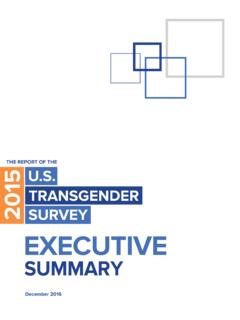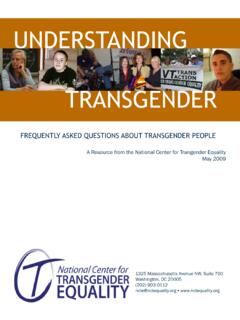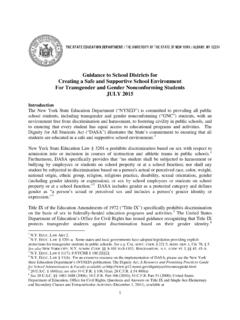Transcription of LGBTQ PEOPLE BEHIND BARS - National Center for …
1 LGBTQ PEOPLE BEHIND BARSA GUIDE TO UNDERSTANDING THE ISSUES FACING transgender PRISONERS AND THEIR LEGAL RIGHTSN ational Center forEQUALITYTRANSGENDERThis is a guide to understanding the experiences of transgender and LGBTQ PEOPLE in jails and prisons for anyone who wants or needs to learn more, including staff members of correctional facilities and external advocates. This guide also includes an overview of the legal rights of transgender and all LGBTQ prisoners, including Constitutional rights. For detailed information on what policies jails and prisons should adopt, see POLICIES TO INCREASE SAFETY AND RESPECT FOR transgender PRISONERS: A guide for agencies and advocates.
2 If you are an external advocate (not currently on staff at a correctional facility) trying to work to improve jail or prison conditions, see also: ENDING ABUSE OF transgender PRISONERS: A guide for advocates on winning policy changeLGBTQ CRIMINAL JUSTICE REFORM: Real steps LGBTQ advocates can take to reduce assistance in policy development and review, please contact Racial and Economic Justice Policy Advocate, Mateo De La Torre, at or 202-804-6045, or or all press inquiries related to this document or NCTE s work regarding prison policy and its impacts on transgender PEOPLE , please contact Media Relations Manager Gillian Branstetter at US ON SOCIAL MEDIA TransEquality WHY PRISONS ARE AN LGBTQ JAILS, PRISONS, AND OTHER CONFINEMENT FACILITIES: AN THE CURRENT STATE OF THE KEY ISSUES FACING LGBTQ NCTE | LGBTQ PEOPLE BEHIND BARS.
3 A GUIDE TO UNDERSTANDING THE ISSUES FACING transgender PRISONERS AND THEIR LEGAL RIGHTSINTRODUCTIONJAILS AND PRISONS ARE TRAUMATIZING AND OFTEN DANGEROUS places, especially for lesbian, gay, bisexual, transgender , and queer ( LGBTQ ) PEOPLE and anyone who doesn t fit gender stereotypes. In a country that incarcerates more of its PEOPLE than any other large nation in the world, LGBTQ PEOPLE are more likely to end up BEHIND bars and more likely to face abuse BEHIND bars than the general population. Being LGBTQ in a jail or prison often means daily humiliation, physical and sexual abuse, and the fear that it will get worse if you complain. Many LGBTQ PEOPLE are placed in solitary confinement for months or years just because of who they , the movement to end these harmful practices and combat mass incarceration as a whole is growing.
4 Grassroots movements challenging mass incarceration and brutal prison conditions are gaining steam, courts are increasingly recognizing legal protections for transgender and LGBTQ prisoners, and the federal government adopted landmark regulations, known as the PREA Standards, that provide critical protections for LGBTQ PEOPLE and others vulnerable to violence in prisons. More and more corrections agencies are paying attention and many are now adopting new policies aimed at protecting LGBTQ prisoners. While there is still a huge amount of work to be done to reduce the harms that LGBTQ PEOPLE and others face BEHIND bars and to keep them out of prisons and jails in the first place now is a better time than ever for our communities to press for overview provides an introduction to the needs and experience of many LGBTQ prisoners, as well as the legal protections they have under the Constitution, the Prison Rape Elimination Act, and other laws and standards.
5 5 NCTE | LGBTQ PEOPLE BEHIND BARS: A GUIDE TO UNDERSTANDING THE ISSUES FACING transgender PRISONERS AND THEIR LEGAL RIGHTSWHY PRISONS ARE AN LGBTQ ISSUEPRISONS AND JAILS ARE INHERENTLY HARMFUL FOR MANY PEOPLE , LGBTQ or not, but LGBTQ PEOPLE often face unique risks in these settings. LGBTQ PEOPLE are overrepresented in prisons, and they are often especially vulnerable to violence and other forms of mistreatment in these settings. This section discusses some of the disproportionate harms LGBTQ PEOPLE face in the criminal justice system and why the needs of LGBTQ prisoners must be a central issue for advocates. Disproportionate Contact with the Criminal Justice SystemLGBTQ PEOPLE , particularly LGBTQ PEOPLE of color and low-income LGBTQ PEOPLE , are disproportionately likely to come into contact with the criminal justice A history of bias, abuse, and profiling toward LGBTQ PEOPLE by law enforcement, along with high rates of poverty, homelessness, and discrimination in schools and the workplace, has contributed to disproportionate contacts with the justice system, leading to higher levels of Policies that criminalize poverty, homelessness.
6 And participation in survival economies such as sex work also disproportionately impact LGBTQ PEOPLE especially transgender women of 2015 transgender Survey, a study of nearly 28,000 transgender adults, showed patterns of frequent harassment, profiling, and abuse by law enforcement officers and high rates of Just in the past year, 2% of respondents had been incarcerated,5 more than twice the rate in the general population ( ).6 The incarceration rate was several times higher among transgender PEOPLE of color and low-income respondents. For example, nearly one in ten (9%) Black transgender women were incarcerated in the previous year, approximately ten times the rate in the general Similarly, one in six (16%) respondents in the 2008 09 National transgender Discrimination Survey had been incarcerated at any point during their lives, with the rate skyrocketing to 47% among Black transgender also show that lesbian, gay, and bisexual (LGB) adults are overrepresented in jails and prisons.
7 Federal data suggests that LGB PEOPLE are three times as likely to be incarcerated as the general population, and over 40% of incarcerated women are lesbian or And while an estimated 7% of youth in the are LGB, between 12% and 20% of youth in juvenile detention facilities identify as LGB, and in one study, 85% of incarcerated LGB youth were PEOPLE of Family rejection, homelessness, hostility in the foster care system and other safety net systems, and the disproportionate impact of the school-to-prison pipeline often serve to funnel LGBTQ youth into the juvenile justice Levels of Abuse in Prisons and JailsThe United States incarcerates PEOPLE at the highest rate of any nation in the Nearly 7 million adults are under correctional supervision in the today, with nearly million of them in prisons and In addition, it is estimated that over 50,000 are held in juvenile prisons on any given day,14 and the Department of Homeland Security placed over 350,000 PEOPLE in immigration detention in While conditions in jails and prisons vary, overcrowding, physical and sexual violence.
8 And heavy reliance on solitary confinement are common. The United States Constitution guarantees that PEOPLE deprived of their liberty must be provided with adequate 6 NCTE | LGBTQ PEOPLE BEHIND BARS: A GUIDE TO UNDERSTANDING THE ISSUES FACING transgender PRISONERS AND THEIR LEGAL RIGHTS food, shelter, safety, and medical care, yet these standards are often not these settings, LGBTQ PEOPLE are especially vulnerable to abuse and mistreatment, by both staff and other prisoners. According to federal data, transgender PEOPLE are nearly ten times more likely to be sexually assaulted than the general prison population, with an estimated 40% of transgender PEOPLE in state and federal prisons reporting a sexual assault in the previous In the same federal survey, prisoners who identified as LGB were approximately three times as likely to report sexual abuse as other Just as in any other setting, sexual abuse BEHIND bars can lead to post-traumatic stress disorder, depression, substance abuse, and other consequences that can take a heavy toll on survivors of sexual abuse, their families and communities.
9 And the health and criminal justice prisoners also face many other forms of mistreatment BEHIND bars. Many face constant humiliation and degradation from staff and prisoners alike. Staff who often are responsible for perpetuating abuse themselves may blame LGBTQ prisoners for their own victimization, believing they are flaunting themselves and refusing to take grievances or reports of abuse seriously. If their vulnerability is recognized at all, it may be by placing them in indefinite solitary confinement, with little or no activity or human contact conditions that can cause serious psychological harm and trauma, and which, as medical and human rights experts have found, can amount to In other cases, LGBTQ prisoners requests for temporary protective custody are and gender nonconforming PEOPLE often face additional forms of mistreatment.
10 Though practices are changing, many facilities still house transgender PEOPLE strictly according to their genital anatomy or the gender they were thought to be at birth often increasing their vulnerability to abuse. Facilities may deny them access to gender-appropriate clothing or grooming items, and punish them for attempting to express their gender identity. In addition, some facilities still place decisions about the medical needs of transgender PEOPLE in the hands of administrators rather than health care providers, adopting blanket policies against providing hormone therapy or other transition-related Center for American Progress & Movement Advancement Project.










![WELCOME! [www.thetrevorproject.org]](/cache/preview/b/8/d/9/a/1/c/7/thumb-b8d9a1c7785968c282cb5f8ffa51c8c7.jpg)


